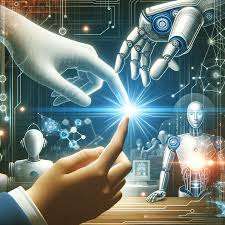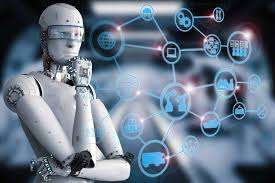Artificial intelligence (AI) has become a ubiquitous term, woven into the fabric of our daily lives. From the moment we wake up and interact with our smart speakers to the personalized recommendations that populate our social media feeds, AI is subtly shaping our experiences. Science fiction has long captured our imaginations with visions of sentient robots and artificial superintelligence. While these may remain distant possibilities, AI’s capabilities are already exceeding expectations and transforming our world in profound ways. This blog delves into the current state of AI, exploring what it is and what it can do. We’ll unpack the different facets of AI technology, from machine learning algorithms that learn from data to natural language processing that allows machines to understand and generate human language. We’ll then explore the diverse applications of AI that are making waves across numerous industries, from healthcare and finance to manufacturing and transportation. However, the rise of AI also brings with it a set of questions and concerns. We’ll address these concerns head-on, exploring the potential impact of AI on jobs and the importance of developing and deploying AI responsibly. Ultimately, the future is not about humans versus machines, but about humans and machines working together. By fostering a collaborative partnership between human and artificial intelligence, we can unlock the true potential of AI and navigate a future filled with exciting possibilities.pen_sparktunesharemore_vert

Demystifying AI: What It Is and What It Can Do
AI encompasses a broad range of technologies that enable machines to simulate human cognitive functions like learning, problem-solving, and decision-making. This can involve:
- Machine Learning: Algorithms that learn from data, identifying patterns and making predictions without explicit programming. This is the foundation for many AI applications.
- Deep Learning: A type of machine learning inspired by the structure and function of the human brain, particularly effective in tasks like image recognition and natural language processing.
- Computer Vision: The ability for machines to analyze and understand visual information from images and videos.
- Natural Language Processing: The ability for machines to understand and generate human language, enabling applications like chatbots and voice assistants.
While AI cannot replicate human consciousness or emotions, it excels at tasks that involve vast amounts of data, complex calculations, and repetitive analysis. This makes it a powerful tool with a wide range of applications.
AI in Action: Transforming Industries
AI is already making waves across numerous industries:
- Healthcare: AI is aiding in disease diagnosis, drug discovery, and personalized medicine. Imagine AI-powered systems analyzing medical scans to identify abnormalities with incredible accuracy, or developing personalized treatment plans based on a patient’s unique genetic makeup.
- Finance: AI is used for fraud detection, risk assessment, and algorithmic trading. This allows financial institutions to detect fraudulent transactions more efficiently, manage risk with greater precision, and make informed investment decisions.
- Manufacturing: AI is driving automation in factories, optimizing production processes, and improving quality control. Robots perform tasks with increased accuracy and efficiency, leading to improved production outputs and reduced costs.
- Transportation: The development of self-driving cars is a prime example of AI’s potential in transportation. AI can analyze sensor data to navigate roads safely and efficiently, potentially revolutionizing the way we travel.
These are just a few examples, and the potential applications of AI continue to expand rapidly. However, it’s important to remember that AI is a tool, not a replacement for human intelligence.
The Human-AI Partnership: Collaboration for a Better Future
One of the biggest concerns surrounding AI is the potential for job displacement. While AI automation may render some jobs obsolete, it’s more likely to create new opportunities. The future workplace will require a fusion of human and machine intelligence. Humans will continue to be needed for their creativity, critical thinking, and social skills. AI will augment human capabilities, performing tasks that are repetitive, data-driven, or require high levels of precision.
The key to unlocking the full potential of AI lies in fostering collaboration between humans and machines. By leveraging AI’s strengths and combining them with human expertise, we can achieve remarkable things. Imagine scientists utilizing AI to analyze vast amounts of data and accelerate scientific breakthroughs, or educators using AI-powered personalized learning platforms to cater to individual student needs.
Navigating the Future: A Responsible Approach to AI
The development and deployment of AI must be approached with responsibility. Here are some key considerations:
- Ethical Development: AI algorithms should be developed and implemented in a way that is fair, unbiased, and does not discriminate against any group.
- Transparency and Explainability: It’s crucial to understand how AI systems make decisions, especially when these decisions have significant consequences.
- Human Oversight: AI should be a tool to empower humans, not replace them. Human oversight is essential to ensure responsible and ethical use of AI.
By fostering a responsible approach to AI, we can harness its power for good, creating a future where humans and machines work together to solve complex problems, improve our lives, and build a more sustainable and equitable world.
Conclusion:
AI is no longer a futuristic fantasy confined to science fiction movies. It’s a powerful force that’s already woven itself into the fabric of our daily lives. From the moment we wake up and interact with our smart speakers to the way AI personalizes our online experiences, it’s subtly shaping our world. The potential of AI continues to expand at an astonishing rate. This blog explores the exciting world of AI, delving into its capabilities and the profound impact it’s having across numerous sectors. We’ll unpack the different facets of AI technology, from machine learning algorithms that learn from data to natural language processing that allows machines to understand and generate human language. We’ll then explore the diverse applications of AI that are making waves across numerous industries, from healthcare and finance to manufacturing and transportation. However, the rise of AI also necessitates a responsible approach. We’ll address some common concerns surrounding AI, such as its potential impact on jobs. Ultimately, the future is not a competition between humans and machines. It’s about fostering a collaborative partnership where humans and AI work together to create a better world. By embracing AI responsibly and fostering human-AI collaboration, we can unlock its true potential and navigate a future filled with exciting possibilities for all.

More on:
- https://www.micro2media.com/a-root-revolution-ai-empowers-plants-to-fight-climate-change/
- https://www.cgc.edu.in/blog/how-is-artificial-intelligence-revolutionizing-the-world
- https://www.remindercall.com/resources/the-rise-of-the-machines-how-automation-is-revolutionizing-our-world/
- https://www.micro2media.com/navigating-the-evolving-landscape-top-business-it-trends-in-2024/